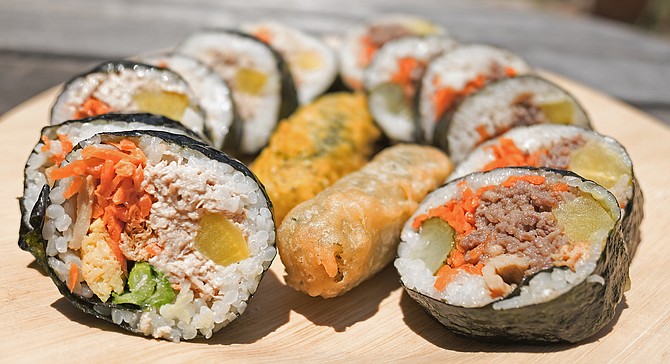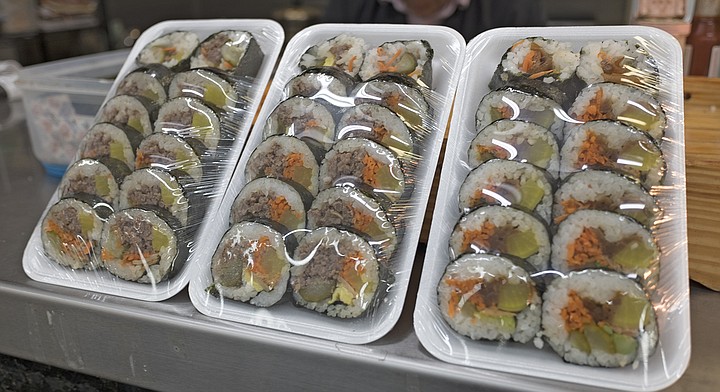 Facebook
Facebook
 X
X
 Instagram
Instagram
 TikTok
TikTok
 Youtube
Youtube

Most of the time I visit Korean grocery store Zion Market, it’s for a quick bite in its food court. That’s at the front of the store, all the way to the right as you enter. There’s a fair variety of fast-food counters serving affordable noodle and rice dishes and the like.

This time I went looking for something a little different: kimbap. For that, I had to find the colorful back-of-the-store counter called Old Street Food.
Kimbap (or gimbap, according to the Global Error Monitoring Staff) is often called Korean sushi because it involves rolling rice up in a seaweed wrapper and slicing it into pieces, like maki rolls. But as the plastic-wrapped trays of beefy kimbap greeting you at the Old Street Food counter show, you can roll up a lot more than raw fish.

Specifically, this was bulgogi kimbap, made with the Korean BBQ staple of thinly sliced, marinated, and grilled beef. Except here the bulgogi is served cold to match the other ingredients squeezed into that nori wrapper. That would include julienned carrots, sweet pickled radish, pickled zucchini, and fish cake. Basically, some of the leftovers from a Korean meal of beef, rice, and banchan.
I asked the older gentleman making these dishes behind the counter if I would enjoy it better with any sauce, and he assured me it has enough flavor on its own.

A mere five bucks gets you a serving of twelve pieces, so I decided to try a tuna kimbap for comparison. I scanned the rest of the menu (composed of cheap food photos strung up around the counter) and found an interesting side dish — glass noodles rolled up in seaweed and fried in tempura batter, three for two dollars.
As the eatery’s name and prices suggest, Old Street Food ain’t exactly haute cuisine. There are chairs at the counter, in case you do enjoy dining amidst squeaking shopping carts under the fluorescent lights of a busy supermarket. But this stuff is more like picnic food, and as such it’s packaged to go. So I took the ad hoc lunch to my backyard.
And happily feasted. First, those fried noodles. What can I say? They tasted exactly as you’d want them to, in the event you ever considered fried seaweed and noodles together. I could have eaten ten.
With the sushi association in mind, I thought the tuna kimbap would feature raw ahi, but it was some variety of shredded tuna, like you get in a can. At five bucks a roll, that’s probably for the best. This one shared plenty of ingredients with the beef roll, replacing zucchini with spinach and adding omelette. Each also had pieces of sweet tofu skin in the mix, contributing to an unusual combination of sweet and savory flavors throughout.
Texture-wise, the kimbap did eat like adventurous sushi rolls, but my sushi has never tasted like this. I liked the beef slightly more, but for a quick five-dollar meal, consider me sold on Old Street Food either way.


Most of the time I visit Korean grocery store Zion Market, it’s for a quick bite in its food court. That’s at the front of the store, all the way to the right as you enter. There’s a fair variety of fast-food counters serving affordable noodle and rice dishes and the like.

This time I went looking for something a little different: kimbap. For that, I had to find the colorful back-of-the-store counter called Old Street Food.
Kimbap (or gimbap, according to the Global Error Monitoring Staff) is often called Korean sushi because it involves rolling rice up in a seaweed wrapper and slicing it into pieces, like maki rolls. But as the plastic-wrapped trays of beefy kimbap greeting you at the Old Street Food counter show, you can roll up a lot more than raw fish.

Specifically, this was bulgogi kimbap, made with the Korean BBQ staple of thinly sliced, marinated, and grilled beef. Except here the bulgogi is served cold to match the other ingredients squeezed into that nori wrapper. That would include julienned carrots, sweet pickled radish, pickled zucchini, and fish cake. Basically, some of the leftovers from a Korean meal of beef, rice, and banchan.
I asked the older gentleman making these dishes behind the counter if I would enjoy it better with any sauce, and he assured me it has enough flavor on its own.

A mere five bucks gets you a serving of twelve pieces, so I decided to try a tuna kimbap for comparison. I scanned the rest of the menu (composed of cheap food photos strung up around the counter) and found an interesting side dish — glass noodles rolled up in seaweed and fried in tempura batter, three for two dollars.
As the eatery’s name and prices suggest, Old Street Food ain’t exactly haute cuisine. There are chairs at the counter, in case you do enjoy dining amidst squeaking shopping carts under the fluorescent lights of a busy supermarket. But this stuff is more like picnic food, and as such it’s packaged to go. So I took the ad hoc lunch to my backyard.
And happily feasted. First, those fried noodles. What can I say? They tasted exactly as you’d want them to, in the event you ever considered fried seaweed and noodles together. I could have eaten ten.
With the sushi association in mind, I thought the tuna kimbap would feature raw ahi, but it was some variety of shredded tuna, like you get in a can. At five bucks a roll, that’s probably for the best. This one shared plenty of ingredients with the beef roll, replacing zucchini with spinach and adding omelette. Each also had pieces of sweet tofu skin in the mix, contributing to an unusual combination of sweet and savory flavors throughout.
Texture-wise, the kimbap did eat like adventurous sushi rolls, but my sushi has never tasted like this. I liked the beef slightly more, but for a quick five-dollar meal, consider me sold on Old Street Food either way.
Comments